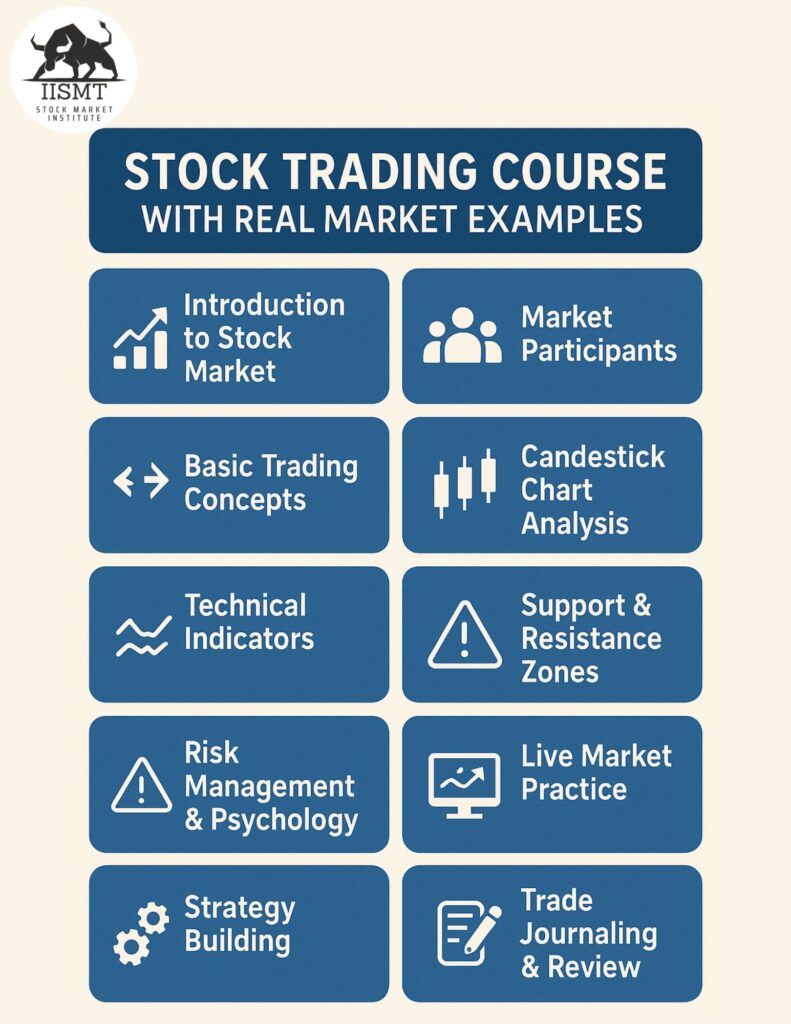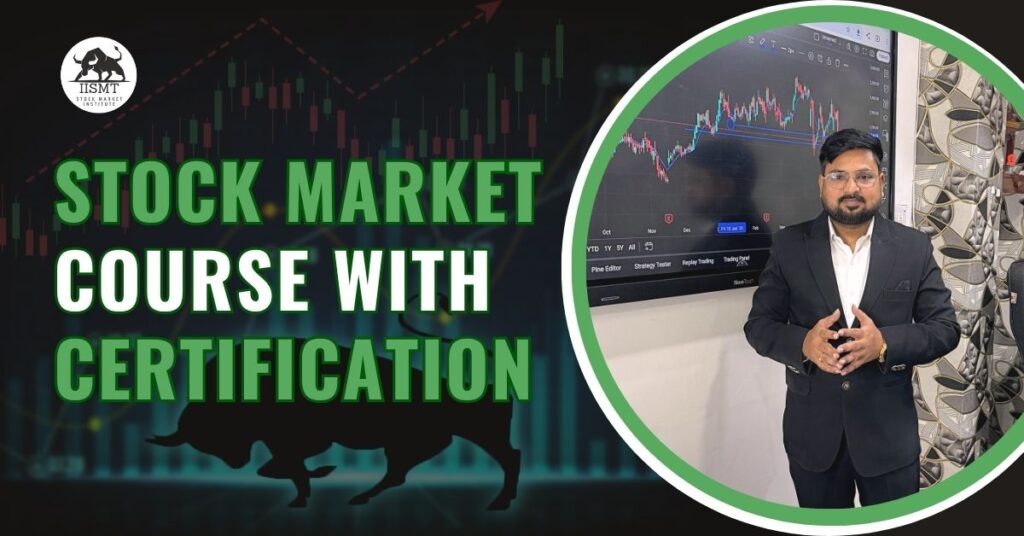In the fast-paced world of finance today, studying stock trading is no longer a luxury but a necessity for anyone who wishes to accumulate wealth, become economically independent, or even use the stock market as a full-time profession. Yet, with hundreds of courses online and offline, few can connect theory to actual market exposure. That’s where a Stock Trading Course with Real Market Examples and illustrations plays a key role.
If you are a student, professional, or simply seeking side income prospects, such a course can provide the tools and confidence to become a successful trader from day one.

Why You Need a Stock Trading Course with Real Market Examples
Stock trading is not defined by memorisation and books. It is about reading charts, responding to price action, risk management, and taking action in the moment. A Stock Trading Course with Real Market Examples enables you to observe how theory is practised in actual live markets.
Here’s why it’s superior to conventional theory-based courses:
- Live chart analysis rather than static textbook charts
- Simulated trading or live trading with expert guidance
- Real-time market-breaking news analysis
- Every day practice with support and resistance, breakouts, and indicators
- Real winners and losers, rather than theoretical examples
Who Should Take This Course?
A stock trading course with real market examples is perfect for:
- Novice traders with zero experience in trading or finance
- Intermediate traders are stuck in the theory phase.
- Working professionals looking to build a side income.
- Retired citizens looking to take care of their savings
- Students seeking professional avenues in finance
What Do You Learn with a Stock Trading Course with Real Market Examples?
This is an overview of what such a course would typically include, module by module:
1. Stock Market Fundamentals
- Functioning of the stock market
- Stocks, indices, derivatives – what’s the difference?
- Live demo: Live operations on NSE/BSE websites, looking at live price action
2. Trading Instruments and Order Types
- Equity, intraday, futures, options
- Market, limit, stop-loss orders
- Real example: Putting a trade on a live platform such as Zerodha or AngelOne
3. Technical Analysis Basics
- Technical indicators like EMA, RSI, and MACD
- Live analysis: Apply these tools to trending stocks using TradingView
4. Support, Resistance, and Price Action
- Detection of important zones where the price responds
- Live practice: Identification of S&R levels on Nifty/Bank Nifty charts
- Entry/exit strategy based on live examples
5. Fundamental Analysis Simplified
- Reading balance sheets, P&L, and ratios
- Real company case study: e.g., analysing Infosys’ financials post quarterly results.
6. Risk Management and Psychology
- Managing feelings under actual market stress
- Actual trade analysis: Why psychology led to a loss or preserved a win
- Journaling and ongoing trade monitoring
7. Developing and Executing Strategy
- Swing trading strategies
- Intraday push strategies
- Actual trades: Executing strategy live with instruction from a mentor
Below is a table summarising the core modules of the Stock Trading Course with Real Market Examples:
| Module | Key Concepts Covered | Real Market Example |
|---|---|---|
| Stock Market Basics | Exchanges, indices, order flow | Live walkthrough of NSE/BSE sites, watching price action on HDFC Bank |
| Order Types & Instruments | Market, limit, stop loss, F&O basics | Placing a market and limit order live using Zerodha |
| Technical Analysis | RSI, MACD, EMA, Bollinger Bands | Analyzing Infosys chart on TradingView with live indicators |
| Candlestick Patterns | Doji, Engulfing, Hammer, Shooting Star | Spotting real-time candlestick reversals in Bank Nifty |
| Support & Resistance | Price zones, breakouts, false breakouts | Drawing key levels on live chart during market hours |
| Fundamental Analysis | PE, EPS, ROE, news impact | Real quarterly result analysis of companies like TCS or Reliance |
| Trading Psychology & Risk | Emotions, discipline, SL, trade journal | Reviewing a student’s live trade and discussing psychology behind their decisions |
| Intraday & Swing Strategies | Entry-exit strategies, breakout trading | Real-time execution of breakout in trending stocks like Tata Motors |
| Live Market Practice | Watchlist creation, execution, journaling | Taking trades during class with mentor supervision and post-market review |
| Portfolio Building & Investing | Long-term stock selection, diversification | Analyzing the 5-year chart and fundamentals of HDFC Bank for investment |
Benefits of Real Market Example
A Stock Trading Course with Real Market Examples does not instruct you on how the market will operate, it instructs you on how it does operate. Markets are emotional, irrational, and often driven by factors that books can’t predict. Live examples help you prepare for that chaos.
Practical Confidence:
- When you test real-time charts and put trades under observation, your learning curve decreases by leaps and bounds. You no longer second-guess yourself and begin to believe in your setups.
Real-Time Strategy Testing:
- Learning about a breakout strategy is one thing. But watching it unfold on Reliance or HDFC Bank intraday before your eyes is a different ball game, totally
Decision-Making Under Pressure:
- Markets are quick. Your buy/sell decisions must be quicker. Rehearsing the same in a real-life controlled environment sharpens your reflexes and improves your confidence.

Example of a Real Market outline from the Course
Let’s say Nifty is consolidating for three days. On Day 4, it crosses a major resistance level.
On a Stock Trading Course with Real Market Examples, you will:
- Examine the breakout on live charts.
- Confirm using EMA and RSI.
- Take a real or practice trade with a predetermined SL and Target.
- Observe how the trade goes live.
- Document the result and see what went right/wrong.
- This type of experience is what develops you into a proficient trader, not merely a theoretical one.
Why Choose IISMT for a Stock Trading Course with Real Market Examples?
At IISMT (Indian Institute of Stock Market Training), our courses are built on the belief that markets should be learned inside a Stock Trading Course with Real Market Examples, not outside them. That’s why our curriculum is structured with:
✅ Regular live market practice
✅ Mentor-led trade planning and execution
✅ Live reading of charts
✅ Live interpretation of financial news
✅ 1:1 feedback sessions at the end of each market day
Our trainers not only teach, but also actively trade. That means you learn from professionals who go through the same Stock Trading Course with Real Market Examples, heat as you will.
Certificate + Career Guidance
After finishing the stock trading course with live market examples, you get:
- Certificate of Completion
- Live trade performance report
- Resume and job interview assistance (for finance profiles)
- Access to a community of traders and mentors
How Does This Help in the Real World?
Whether you want to trade independently, become a financial influencer, or get a job in a trading firm, a stock trading course with real market examples is your best foundation.
- For freelancers: Trade confidently for daily/weekly income
- For job seekers: practical experience in your resume.
- For investors: Assists in making better entries/exit timing and portfolio management.

Conclusion: Don’t Just Learn Trading, Live It
The stock market rewards prepared people. But preparation is not achieved by watching YouTube tutorials or reading blog posts. It comes from acting.
A Stock Trading Course with Real Market Examples delivers that “doing” edge. It exposes you to live market madness, pressure psychology, and clarity that you must have to survive and prosper.
If you’ve had enough of theory and are ready to trade with authority, this is your time. Allow real markets to instruct you, which books can’t. So if you want other information regarding the course, you can contact us today!




